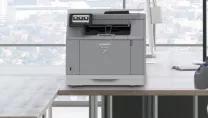The print industry is no stranger to change. No longer is print merely about toner on paper but increasingly about the infrastructure that surrounds it - both on premises and in the cloud. Here, Jason Cort, European Director Product Management and Marketing, explores the key predictions and trends that will define the future of print in 2025 and beyond.
Over the next 12 months, businesses will need to adapt to a rapidly evolving landscape shaped by AI, automation, sustainability demands, cloud technology, and heightened security requirements. There are challenges to be faced, but also cutting-edge technologies to transform and elevate workplace innovation.
Print Automation and AI Integration
Automation has always been important in print, and it continues to transform workflows. Print vendors need to be aware that devices are much more than just for printing, as the scanner, for example, allows for the creation of smarter digital workflows.
Rather than seeing any huge trend changes in print, we are seeing a continual evolution of capabilities. In part, this is being driven by AI, which is enabling what were previously quite complex integrations and setups to be done semi-automatically. For example, AI can automate the creation of workflows that previously would have required a designer, or be coded manually, during deployment thereby increasing service costs. Such AI processes reduce complexity and costs for businesses of all sizes.
In print, we have already started to see trends around AI simplifying and personalising the use of technology within a business, helping reduce the number of steps to accomplish a print task, for example, or assisting in helping to personalise how people use devices.
Looking ahead, AI-driven print systems may well be used to improve device efficiency further, such as suggesting optimal power modes for the streamlining of energy use. Also, it can predict printer maintenance needs, minimising downtime and avoiding costly repairs. AI could be used to dynamically decide the best print output - black-and-white or low-resolution, for example - based on document content, saving costs and resources for the business. Additionally, AI will be able to enhance scanning quality and even summarise scanned documents for smarter ways of working.
Sustainability in Print is on the Rise
In recent years, sustainability and environmental issues have become top priorities for companies. Within the workplace it is no longer a "nice-to-have" but has become a critical aspect of business operations. This trend is heavily influencing customer decisions but at the same time being shaped by wider regulatory requirements.

We are seeing that manufacturers are increasingly adopting the use of recycled plastics within the build phase, with some devices now containing up to 50 per cent recycled content. We are also seeing a large reduction in packaging waste. These are very physical signs of the print industry is moving to smarter production methods but there is still much more that can be done.
Despite economic challenges, businesses must invest in green initiatives now to ensure a viable future. The print industry in Europe is seeing new sustainability regulations introduced, either as draft proposals to give manufacturers time to prepare, or as laws taking effect.
For example, Sharp is not alone in designing modern printing equipment with lower energy consumption. Such steps make it possible for organisations to help meet eco-targets without sacrificing workplace performance.
It is not just print vendors that play a role in sustainability, as end-users also have a part. For example, the use of tools that actively track an organisation’s environmental impact, such as carbon footprint dashboards, are helping users understand their contributions to sustainability. It’s a trend we are seeing steadily increase within larger organisations and into SMEs. This shift to understanding an organisation’s impact goes beyond surface-level indicators, allowing the business to align with stricter regulations, such as the Corporate Sustainability Reporting Directive (CSRD). The directive became effective back in January 2024, so businesses truly need a plan in place for execution in 2025.
It is easy to see that in the coming years those businesses that fail to provide transparent and measurable sustainability data risk losing customers and falling short of compliance standards.
Smarter Cloud Technology Integration
Cloud continues to be a trend that SMEs will adopt. Even traditionally cautious markets, such as Germany, are accelerating cloud adoption. As a result, businesses are no longer self-contained units, they are connected to a wider IT infrastructure, often owned and managed by third parties.
However, we believe that as businesses increasingly move to the cloud, the print industry must follow suit, ensuring devices and workflows integrate seamlessly and securely into this environment.
As print devices now function as part of a larger IT ecosystem, it is imperative that they offer compatibility with broader platform services, whether Microsoft Azure, Google Workspace, or Amazon Web Services. Print Management Software (PMS) is the best way to ensure that devices connect and work with such platforms, but it is not a necessity in all cases.
What is vital with any form of cloud connectivity is for the end-user to understand security and the challenges around it. As print devices increasingly become digital hubs within a business, Cloud connectivity brings added security challenges. To address this, many device manufacturers are adopting Zero Trust Architecture (ZTA), where user authentication via identity providers ensures a secure environment. ZTA is a cybersecurity model based on the principle of "never trust, always verify" and requires continuous authentication, authorisation, and strict access controls for all users, devices, and applications, regardless of their location.
Sharp is in a fortunate position in that it offers a broad range of IT consultancy to SMEs, especially around security and print accessibility. This means we can help organisations of all sizes ensure that data around print, who within the organisation has access, and how they use it, is a priority within any business.
Print Security and Beyond
As mentioned, printers are evolving from simple devices into secure IoT solutions in their own rights, requiring encryption and compliance with standards such as NIS 2.0 and Radio Equipment Directive (RED). Printer security has moved from a peripheral concern to a fundamental 'secure by design' principle in modern device development.
The NIS2 Directive is set to change how companies across Europe engage and react to cybersecurity within their organisations. The directive makes it essential for companies to optimise their cyber resilience, including the ability to prevent, withstand and recover from cyber incidents. The Radio Equipment Directive (RED) ensures that connected devices sold in the EU meet essential health, safety, and environmental requirements, and is compatible with the EU's radio spectrum policy.
Sharp Europe is responding to threats in new and innovative ways, such as Synappx Cloud Print or Complete Print Security that delivers ‘always on’ secure protection, both part of our Print Management Solutions.
Modern printers are computers with data transmitted to and from the cloud, whether for printing or storage, which exposes devices to potential vulnerabilities. As a result, solutions must be put in place that include robust encryption and user authentication to mitigate potential breaches. Vendors regardless of device need to understand the implications for their products and adopt to work within these new frameworks as they emerge.
Summing up Print Trends for 2025
Print – or the physical toner and paper aspect of print - is a mature technology and evolution is slow. As a result, the printing function of devices is not really changing. What is changing more quickly every year is the environment around print that devices must plug into. Whether it is cloud technologies, AI, digitisation workflows, or sustainability, all are having an impact on a very traditional and mature market. But to stay relevant we must acknowledge these changes and react.
By embracing these trends, print vendors can not only navigate the challenges ahead but also position themselves as leaders in a competitive marketplace. As 2025 approaches, the future of print will depend on how well the industry evolves alongside these external shifts.
This article was compiled following a discussion with the Sharp Europe product marketing team: Jason Cort (European Director Product Management and Marketing), Rob Davis (Solutions & Services Business Manager), Claudio Roselli (Head of Product Management and Software Development), and Ben Lake (Senior Product Manager - MFP & Printer Products).





